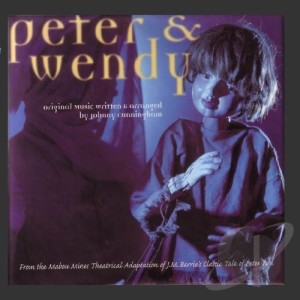 A rich montage of songs and sounds combine to bring the listener to the world of Neverland to retell the story of Peter Pan and Wendy. This music was used in a theatrical production of Peter Pan, using puppetry, light, and shadow to create the magical world of J.M. Barrie. The magic begins with a bit of narration, “All children grow up. They know they will grow up…” This is followed by a plaintive melody, carried by Seamus Egan’s haunting flute and accompanied by the rich strains of Jay Ansill’s harp. As more instruments enter, the melody carries the listener away to the day Wendy met Peter Pan. The rest of the story follows, without narration, told solely through the music.
A rich montage of songs and sounds combine to bring the listener to the world of Neverland to retell the story of Peter Pan and Wendy. This music was used in a theatrical production of Peter Pan, using puppetry, light, and shadow to create the magical world of J.M. Barrie. The magic begins with a bit of narration, “All children grow up. They know they will grow up…” This is followed by a plaintive melody, carried by Seamus Egan’s haunting flute and accompanied by the rich strains of Jay Ansill’s harp. As more instruments enter, the melody carries the listener away to the day Wendy met Peter Pan. The rest of the story follows, without narration, told solely through the music.
Johnny Cunningham, fiddler extraordinaire, has given the story a Celtic feel through the music. His melodies are memorable, the harmonies rich, and the lyrics fun, emotional, playful, serious, humorous, and heartfelt, all at once. To create this nostalgic tale through music, Cunningham is joined by Susan McKeown (vocals), Seamus Egan (whistles, flute, and bodhran), Jay Ansill (celtic harp and mandolin), Larry Campbell (guitar), Jamshied Sharifi (keyboards and percussion), Karen Kandel (vocals and narration), Mick McAuley (accordion), Charlie Giordano (accordion), and Ben Wittman (percussion). The varied styles of the musicians add rich textures to the music of this highly effective ensemble. The CD is packaged with a booklet filled with lush images from the award-winning production, allowing the listener to follow the story while being carried away by the haunting music.
Although this is original music by Johnny Cunningham, you can feel the touch of the various musicians influencing the music. This was clearly a collaborative effort, to some degree. Jay Ansill uses his trademark tremelo technique to create a musical shimmering of light upon water in the tracks “On These Magic Shores” and “Mermaids.” The ethereal sounds of his harp add that all-important magic to many of the tracks. Susan McKeown pulls the listener to the primal edge with her deeply emotional delivery of the lyrics. She almost brings the listener to tears with the nostalgia of “Memories to Bed.” On this and other songs she is backed by Larry Campbell’s masterful folk guitar, as he regularly demonstrates through his work with Bob Dylan’s band. Mick McCauley’s accordion blends with Seamus Egan’s whistles with the polished sophistication of a pair that regularly play together, as they now do in Solas. Jamshied Sharifi’s percussive brand is clearly seared on “Tinkerbell’s Warning.” With tracks such as “The Flight” and “The Duel,” Johnny Cunningham calls on his roots with Silly Wizard.
Susan McKeown’s evocative voice sets the stage for much of the story, calling the listener back to the rich mysteries of childhood. Using a bit of imagination and the lavishly illustrated booklet, the listener can envision the entire play as it unfolds in music. Although there are occasions where a track is obviously incidental music, most can stand alone as highly crafted original Celtic music. When combined with the information from the booklet, images from the story appear to the listener, as clearly as if watching the play. The crocodile comes to life in “The Crocodile Tango,” highlighted with such tongue-in-cheek lyrics as “A leg, a thigh, it just won’t do, I want to chew the all of you.” The mermaid lagoon is as clear as day through the musical imagery of “Mermaids,” from the bubbling waterfall to the birds calling in the air. My favorite tune, “Neverbird,” soars above the misty waters of the mermaid lagoon, calling Peter to live. The strains are memorable — haunting, yet elusive.
Of course, the carefree joys of childhood must end, for all but Peter Pan. Wendy grows up, and we hear the lament in the plaintive strains of the harp, the howling of the wind, and the sad lyrics, “Come again when I’m gone, I’m too old for redeeming.” But new children replace the old, learning the wonders of Neverland, and the careless life of Peter Pan. We can join them, here in the safety of our bedrooms; for without watching the production, you can still see the story through the ingeniously crafted music, and learn to fly.
(Alula, 1997)
COMMENTS
